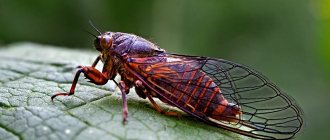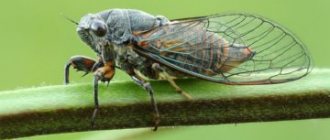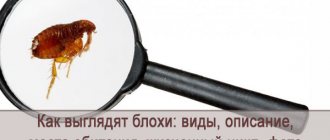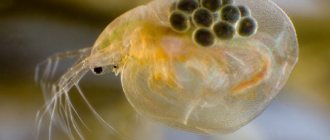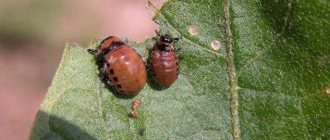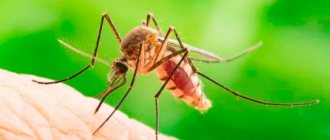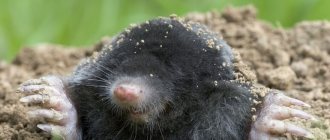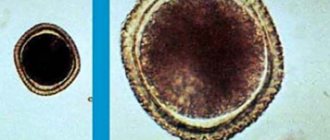02.12.2016
Among the many creatures inhabiting our planet, small but so sonorous cicadas stand out noticeably. People's attitude towards these small insects is very ambiguous: while tourists on vacation enjoy listening to the singing of cicadas, farmers and gardeners unanimously hate them.
- About appearance
- Stages of development
- Diet
- Species and habitats
- Record holders for life expectancy
- Musicians by nature
Characteristics of cicadas
Despite the fact that cicadas are separated into a separate suborder, they have common characteristics of insects. Thus, representatives of this taxon have either transparent or leathery forewings. Folds like a roof. The body is thick, the wings protrude far beyond the tip of the abdomen. The antennae are short and segmented. On the wide head there are 2 compound eyes and three simple ones.
The larvae are delicate, with thin covers, so they live in shelters. At first they live under the bark of trees, then they fall to the ground and burrow quite deeply. Sometimes a whole meter deep. Some representatives protect themselves from predators and drying out by forming a foam around their body.
The length of cicadas is from 2 to 70 mm. Smaller representatives jump excellently, using their hind limbs for this purpose. In large species, all limbs are walking.
Species and habitats
In Russia, most often found are not the largest individuals with a body of 2-5 cm and a wingspan of no more than 10 cm. Separately in the vast family, the mountain cicada, which lives in the USA, Europe and partly in Asia (including the territory of the Russian Federation), stands out, which is considered the most northern view. Externally, these insects are slightly larger than their relatives; on their body you can see an orange pattern on a black background. They prefer to hold their concerts (quite loud) on the surface of the earth and only during the daytime. Since they practically do not harm agriculture and are relatively rare, in some regions they have even been taken under protection by wildlife defenders.
Among the most famous in Russia are the following varieties of cicadas:
- common (the most common representative of the family on the Black Sea coast);
- white metalcafa (especially “famous” in the Krasnodar region for its attacks on citrus plantings);
- humpback or buffalo leafhopper (a very small green insect that loves vineyards);
- green cicada with turquoise wings (lives everywhere where it is warm and is not picky about food);
- rose leafhopper (prefers plants such as rose hips, apple trees, lilacs, roses).
The largest representatives (Megapomponia imperatoria) live in the tropics and reach a length of 7 cm with a wingspan of 18-20 cm, they are also among the most “singing”.
Singing cicadas
Separated into a separate family. The family is also called “true cicadas.” They have a number of common characteristics. The description of song cicadas is as follows: large insects with a thick abdomen, walking legs and well-developed transparent wings. The femurs of the front legs are thickened, with two or three teeth. All representatives have a remarkable ability to sing loudly. There are about 1,500 species of song cicadas in the world. These creatures live mainly in warm climatic zones.
The signs of insects are the same for all representatives of song cicadas. Therefore, having remembered one cicada, it is easy to determine the belonging of other species to the same family.
Appearance of insects
Cicadas are large insects. The body length of most species reaches 5 cm, while some tropical representatives grow up to 15 cm. Cicadas have a short head. If you look closely, in the photo of the cicada insect you can see 5 eyes: 2 large on the sides and 3 small, forming a triangle on the crown. It is believed that these insects have excellent vision, so they notice enemies from a long distance.
Cicadas have two pairs of wings, with the front pair noticeably longer than the back. The wings are most often transparent, but in some species they are brightly colored and in others they are black. The abdomen of the insect is large and thick; in males it turns into the copulation apparatus, and in females into the ovipositor. Males also differ from females in the presence of a vocal apparatus located behind the hind limbs on the lower side of the metathorax.
Singing cicadas
Cicadas sing in a variety of ways. The description of the song is individual for each species. The voice may be similar to the sound of a buzz saw or the monotonous horn of a train. Some songs are distinguished by the presence of two parts, different in sound.
The timbal organs, which produce sound, are located on the ventral side of the body. Special plates cover the device. The cymbals themselves consist of three membranes. The outer membrane is connected to powerful muscles. The muscles change the convexity of the membrane to concavity, and vice versa. The muscles attached to the center of the instrument tense, bending the membrane. Sound is played. Next, the muscles relax, and the membrane returns to its previous position. At this stage, the sound may or may not be heard by the human ear. The result is a chirping sound, like when playing with a convex tin can lid. The remaining membranes (anterior and posterior) resonate with the outer membrane or have their own muscles. The posterior membrane is called the “mirror”. It shimmers beautifully in different colors.
Oscillations occur up to 4000 times per second if there is sufficient heat. However, one hundred times per second is enough for a cicada to chirp. Large air cavities amplify sound - they are resonators. The cavities are connected to spiracles for air supply. By the way, only large representatives sing loudly. The smaller ones also sing, but so quietly that the human ear cannot hear them. For a long time it was believed that only males sing. In 1959, 19 species of European leafhoppers were studied. It turned out that females also sing. However, sound amplifiers are needed so that a person can hear their sounds.
Some representatives sing so loudly that the human ear cannot stand it. This provides excellent protection from predators. Such loud cicadas are common, for example, in the deserts of North America.
The cicada with the longest life cycle lives on the same continent. The larva turns into an adult after 17 years. This is a record among insects. However, not all species of the family have been studied. Perhaps other amazing representatives of song cicadas will be discovered.
Musicians by nature
Most people don't usually think about how cicadas make sound, which is why the expression "singing insect" has caught on in everyday life. In fact, it would be more accurate to call these creatures musicians, because they do not sing or chirp, but play music on their “cymbals.”
All male cicadas have an original device in the lower part of their abdomen in the form of two symmetrical convex membranes, which, under the action of muscles, can be retracted inward, and when relaxed, return to their original position. The sound from these back-and-forth movements of the cymbal organs resonates in special cavities inside the body and turns into the music of the cicadas. For all types it is different both in volume and sound. Special measurements have established that some individuals can “outplay” the car horn and produce sounds of up to 120 dB. Females of most species do not have devices for such “singing”; they mainly make rustling sounds with the help of their wings (males hear them perfectly well).
If you abstract yourself from pressing matters and allow yourself to immerse yourself in the atmosphere on a warm summer evening when the cicadas are singing, you can get no less vivid an impression than from a concert of a good symphony orchestra, only with invisible performers.
Humanity often encounters these insects because of their prevalence on our planet, and therefore there are all sorts of attitudes towards them:
- someone listens to them with pleasure;
- farmers and gardeners fight with them for the harvest;
- residents of China, Burma, Congo and almost all of Latin America eat them with relish (deep-fried cicadas are considered a real delicacy here);
- in some places they are used as souvenirs, music boxes and toys (for example, in Provence) and used as a symbol.
To briefly outline who cicadas are, it would probably be correct to call them amazing creatures that leave few people indifferent.
Lifestyle
What does a cicada eat? The larvae live underground, where they feed on the sap of young plant roots. They also suck the juice from the underground part of the stem. What does a cicada eat when it grows up? Adult representatives pierce the cell walls of plants with their proboscis and drink the juice. After the insects eat, the juice continues to be released. A droplet of nutrient liquid is formed. It freezes in the air. Manna is what these droplets are called.
Thus, the habitat of song cicadas is a biotope with vegetation. Adults love to sing while sitting on trees and bushes. The larvae live in the soil under the same woody plants. Song cicadas are distributed throughout the world.
Signs you're hearing a cicada
How to distinguish the singing of a cicada from the sounds of orthoptera? Cicadas usually produce their trills during the day, especially during the hot afternoon hours. The fact is that singing requires a lot of energy. This energy comes from solar heat. Only a small number of representatives are awake during the twilight hours. In this case, energy is generated by the muscles that are normally used for flight.
Song cicadas sit on trees and bushes, usually taller than human height. So if a song is heard from above, then most likely it is a male trilling.
Life cycle of the song cicada
The female makes a hole in the bark of a fresh young branch of a tree or bush with her ovipositor. Lays eggs in a hole. Larvae emerge from them. At first, they can remain on the branches and feed on the juices of the above-ground parts of the plant. But then they inevitably fall to the ground and immediately begin to burrow into the ground, where it is difficult for insect consumers to find them. There is enough moisture underground, it is cool, there is a lot of food. The larvae have digging limbs. Insects are looking for young roots. They pierce the plant surfaces with a beak-shaped proboscis and suck the juice. They feed this way from one year to 17 years, depending on the type of insect. Plant sap is not very nutritious, so the development of many representatives is delayed for several years.
During the growth process, the larvae molt several times. Before the last molt they come to the surface. They sit on the trunk of the nearest tree. Here an adult emerges from the larva. This is a long process, not a minute one. After emerging from the old skin, the cicada dries its wings for about an hour. An adult lives 1-2 months. Thus, the cicada has a life cycle with incomplete metamorphosis, that is, there is no pupal stage.
Browser support
I kept the markup simple, using multiple backgrounds within the HTML element.
This option is supported by all modern browsers (Firefox 4, Chrome 10, IE9, Opera 11, Safari 5), but, obviously, not by all older versions. However, if backward compatibility is a condition, then tiling in html, body and div container may be a suitable option. The container may not be semantic, but this small indulgence can potentially have a big impact on the entire site. You decide.
These three examples came to mind first, but I'm sure there are many smarter ways to use the idea. For example:
- Endless cityscape
- Unique wood texture
- starry sky
- Dense jungle
- Cloudy sky
Maybe there are some other ideas?
Research on a typical Australian
David Young is an Australian research scientist. He studies the singing of Australian green cicadas (Cyclochila australasias).
This creature, sitting on a tree, begins to sing. After some time, the “soloist” is joined by other males living nearby. It turns out to be a whole choir. Typically, one insect sings for several seconds or minutes. The invertebrate choir continues to sing for a long time. This is how males attract females.
The singing of the green cicada is perceived as a long, loud sound without a change in tone. David Young, having selected an individual sitting alone, recorded the song on a tape recorder. Next, we analyzed the recording on a computer. It turned out that the singing of the cicada is a lot of impulses. Moreover, the right and left instruments work in turn. The number of pulses was usually 230 and at times reached 4000 per second.
During the chirping process, singing cicadas take a special stance. The male raises his abdomen, while his wings diverge slightly to the sides.
Other representatives of the suborder Cycadidae
In addition to the singing representatives, the cicadas include the families of Cicadas, Gorbatkas, and Pennitsa. They all have the same appearance. However, they also have hind jumping limbs.
Cicadas are smaller than true cicadas. Their forewings are dense and leathery. These creatures are very mobile, they fly better than song cicadas. Both larvae and adults live on herbaceous vegetation.
Humpbacks have figured outgrowths on the pronotum. Most diverse in South America.
Pennies are often brightly colored. Their forewings are dense. They jump beautifully, but when in danger they fall to the ground, where they are more difficult to notice. Pennywort larvae have a special adaptation to prevent drying out. They form a foamy mass around themselves, which is why they got their name.
The larva secretes a special liquid - plant sap not absorbed by the body. The larva contains symbionts that secrete mucin. Mucin is added to the secretions. It provides fluid viscosity. The larva foams plant sap with mucin, releasing air bubbles into the mass from its spiracles and whipping it with rapid movements of its legs. So she ends up in her wet house. Penny cicadas are found throughout the world. In Madagascar, for example, drops of foam—the secretions of cicadas—fall from the trees, as if it were raining.
Nanotechnology
Psaltoda claripennis is a cicada, the surface of its wings is covered with microscopic spines. This surface kills bacteria that get on the wings. Scientists plan to use the discovery to create bactericidal materials.
Insects are interesting if you look at them carefully. Scientists still have many species of cicadas and other invertebrates to study. Many amazing discoveries have been made in science, and we still have to learn new secrets from the life of insects, their structure and behavior. Many arthropods lead complex lifestyles. Cicadas have an unusual structure and are record holders among insects. Moreover, they are very beautiful. Anyone who has seen the mass emergence of adult song cicadas from the last stage of the larval nymph will clearly not remain indifferent.
In culture[edit | edit code]
There is a mention of cicadas in the oldest surviving monument of Greek literature - in Homer's Iliad (
XI-IX centuries BC e.). The ancient Greeks greatly appreciated their singing, and Anacreon is known to have written an ode in honor of the cicadas. Cicadas are actually mentioned in Aesop’s fable “The Grasshopper and the Ant” and La Fontaine’s fable “The Cicada and the Ant”, which in turn is a loose translation of Krylov’s fable “The Dragonfly and the Ant”. According to ancient Greek mythology, the goddess Eos turned her aged husband Tithon into a cicada, whom she kidnapped as a young man, captivated by his beauty.
In the countries of the Far East and China, the cicada is considered a summer insect and hides in the ground during winter hibernation. Buddhist sages saw in this system similarities with how a human being is reborn through death, passing from one body to another. In the ancient Chinese tradition, there is a ritual when a jade cicada is placed under the tongue of the deceased in the mouth. This, according to legend, should help him find a worthy embodiment in a new life and allow him to talk in the afterlife. This tradition still exists both in its original form and slightly modified, when a cicada is placed on the body of a deceased person. In Japan, cicadas were associated with summer and the transience of life; They were often depicted in engravings, and poets dedicated poems to these insects.
The cicada is one of the heroes of Victor Pelevin’s novel “The Life of Insects.”
In the book "The Pillars of Creation" by Terry Goodkind, cicadas are mentioned in one of the prophecies, which speaks of their 17-year life cycle.
300 jewels, supposedly in the shape of cicadas (called "golden bees"), were found in the tomb of the first Frankish king, Childeric I (died 482 AD).
Chinese artist Qi Baishi (1864-1957) has a painting called “Autumn Cicada on Lapin Flowers.”
US folk and pop singer Linda Ronstadt glorifies the life of the cicada in the song “La Cigarra”, and at the same time hints at their short life.
There is also a ballet by French composer Jules Massenet, La Cigale.
There is also an animated series “When the Cicadas Cry,” where in each episode the action is accompanied by the drawn-out song of the cicadas.
Fun fact: Many anime series use footage of cicadas.
In the Russian translation of the game The Last of Us, cicadas are a group that opposes the military and plays a major role in the game.
Coin from Ancient Greece: Athena on the left, an owl on the right and a singing cicada sitting under the wing on the bottom left
Coin from Athens: location with cicada indicated
Golden bees (cicadas) inlaid with garnet from Childeric's tomb
A cicada is an insect somewhat similar to a fly, only very large. Especially with its large transparent wings, folded at rest on the sides of the body. But this is not a fly or a beetle. It's just a cicada - the longest-living insect in the world.
A cicada is an insect somewhat similar to a fly, only very large.
